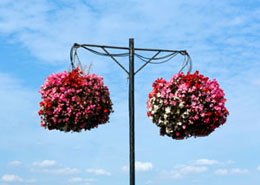Indoor hanging plants like spider plant, wandering jew, Boston fern, purple passion vine, and begonia add a scenic beauty to every room. You can easily maintain these hanging houseplants with basic gardening tips. Ponder on to know some popular indoor hanging plants.

Plants are a wonderful addition to every home, either in the surroundings or indoors. They improve the air quality and at the same time, boost your mood by providing a green environment. Most of us are well-acquainted with hanging plants in the garden and patios, where there is sufficient sunlight exposure. But, what about hanging indoor plants maintained in pots and planters? Popularly known as hanging houseplants, these are varieties that exhibit a trailing growth habit and require low light for growing. Let's take a look at some of the popular indoor hanging plants and care tips in general.
Best Indoor Hanging Plants
Beautify your home interiors with well-chosen indoor hanging plants. You can add greenery to bare walls and dull corners with these hanging plant species. Listed below are some of the preferred hanging houseplants that you can select for your indoor gardening:
- Spider Plant: Spider plant is an all time favorite indoor hanging plant with green or variegated spear like foliage. Within a short time after plantation, its branches overhang the pot from all sides.
- Wandering Jew: As the name signifies, wandering jew shows trailing growth habit. With unique, white to pale green, square-shaped stems, it is a common hanging houseplant. The upper leaf surface is green with silver stripes, while the underside of the leaves is purple in color.
- Boston Fern: Ferns grow best in indoor hanging pots, despite minimal light exposure and moderate watering. You can select Boston fern that will cover the edges of the hanging basket.
- Purple Passion Plant: Purple passion plant is another indoor hanging plant, specifically grown for its fuzzy foliage, highlighted with purple tinge. The leaves are covered with small, soft hair. If you are selecting this, be prepared to pluck the smelly flowering buds before they bloom.
- Begonia: Whether you want attractive foliage or blooms, begonia plants are the ideal choice that provide both of them. Available in various types, you can check out the flower color that will complement your interior design or room decor.
Care for Hanging Indoor Plants
While speaking about tips to care hanging plants, they are mostly similar to those planted in grounded containers. Nevertheless, you should consider certain aspects to maintain healthy indoor hanging plants, which are discussed below:
- A major drawback with such plants is water drainage problem. The best solution for this is using a hanging basket with an attached tray or going for the pot within a pot type. In the latter option, the outer decorative pot is devoid of drainage holes and serve as a water collecting pot.
- Selecting a correct size hanging basket is crucial to maintain indoor hanging plants. Each variety will need a specific size pot, according to which you have to purchase the right size pot of a quality brand.
- An important factor to grow hanging indoor plants is the supporting structure. Whether you are planning to hang planters from the ceiling or any other structure, ensure that it is strong enough to hold the soil-filled pot and plant.
- The potting soil that you use also matters a lot in determining the weight of the hanging plants. For example, peat moss having a high water holding capacity is heavier than perlite. So, if weight is a concern, consider adding perlite to the potting mixture.
- Being indoor plants doesn't mean that they can grow and develop without light. Rather hang these plants inside the room, where there is availability of direct and indirect sunlight (near the doors and windows).
- The amount of required light may vary from one indoor hanging plant to another. If necessary, you can install indoor lights to supplement natural light source for optimal growth of the hanging houseplants.
- Watering should be done properly to avoid flooding the carpet and floor. You can use self-watering pot or a ladder and a long-neck watering can to irrigate them. If possible, take the plants outside and water them on a weekly basis.
Last but not the least, it is to be borne in mind that plants grown in hanging baskets dry out much faster and require more moisture than plants grown in regular grounded pots. Inspect regularly for disease infestations and remove dead leaves. It is worth spending the effort for maintaining indoor hanging plants, as nothing can beat the aesthetic value of these greens in any room.






 Plants are a wonderful addition to every home, either in the surroundings or indoors. They improve the air quality and at the same time, boost your mood by providing a green environment. Most of us are well-acquainted with hanging plants in the garden and patios, where there is sufficient sunlight exposure. But, what about hanging indoor plants maintained in pots and planters? Popularly known as hanging houseplants, these are varieties that exhibit a trailing growth habit and require low light for growing. Let's take a look at some of the popular indoor hanging plants and care tips in general.
Plants are a wonderful addition to every home, either in the surroundings or indoors. They improve the air quality and at the same time, boost your mood by providing a green environment. Most of us are well-acquainted with hanging plants in the garden and patios, where there is sufficient sunlight exposure. But, what about hanging indoor plants maintained in pots and planters? Popularly known as hanging houseplants, these are varieties that exhibit a trailing growth habit and require low light for growing. Let's take a look at some of the popular indoor hanging plants and care tips in general.